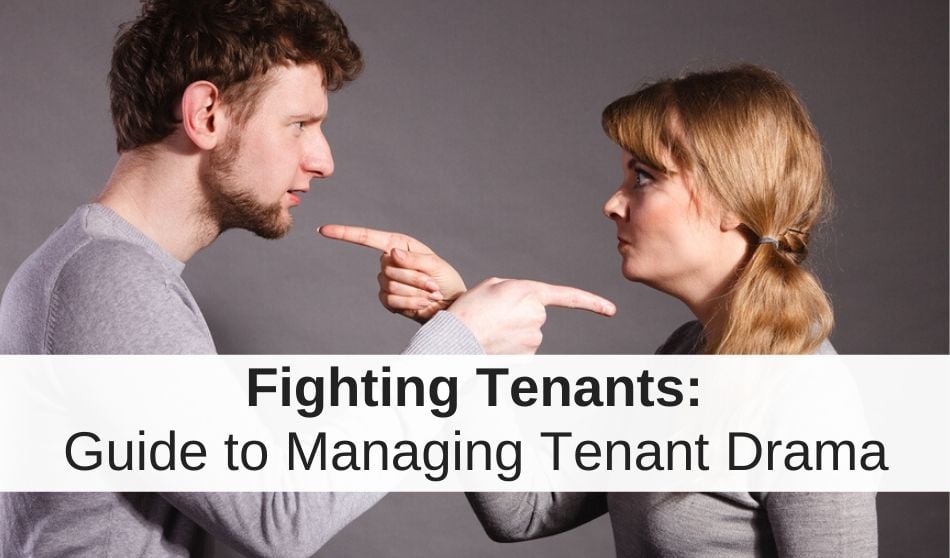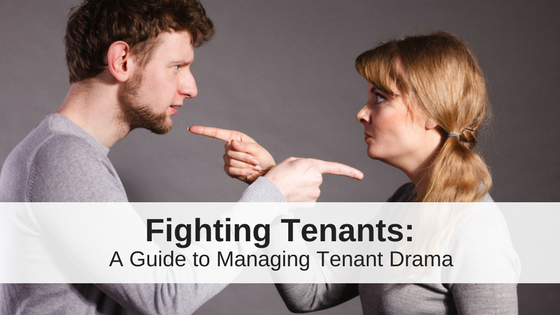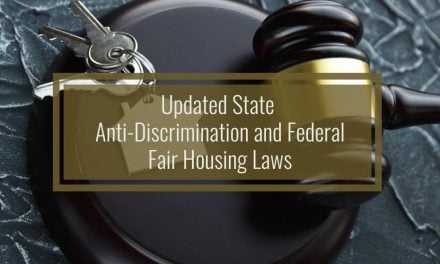
You ran the background checks. You approved credit scores and financial responsibility. References have been verified and security deposit and rent checks have cleared.
You’ve done everything possible to ensure your tenants will respect the property and pay rent on time.
But even the best tenant screening can’t prevent conflicting lifestyles between your neighboring tenants, causing high animosity, leaving you right in the middle of some tenant-on-tenant drama.
What’s a property manager to do?
Whether it is the stomping of a “loud” upstairs neighbor, excessive music or partying late at night, stealing parking spaces, or even aggressive smells permeating the next door unit, every property manager has encountered a tenant complaint about a neighboring tenant.
For the most part, these types of lifestyle complaints can be settled with a little mediation, compromise, and lease enforcement. In cases of serious threats, harassment or violence, legal action might be necessary to ensure the safety and well-being of your tenants.
How to manage fighting tenants
The first step in handling tenant disputes, is to have a solid lease that details rules expected of tenants that promote a safe and peaceful environment.
A safe environment includes provisions about unacceptable harassment, threats or inappropriate behavior directed at other tenants. And a peaceful environment includes conditions that make all tenants feel comfortable regarding nuisance or noise.
Lease terms for a safe and peaceful environment
Some property managers include specific provisions in lease agreements about what is included in a safe and peaceful environment in regards to noise and behavior for all tenants and their guests, and highlight that failure to comply is considered breaking lease terms and grounds for eviction.
If simple disputes and noise complaints cannot be settled with warnings, having a lease in place will assist you if must move on with an eviction.
Create a Resolution Policy and Procedure
To better manage tenant disputes and complaints, it is a good idea to have an established internal policy outlining how to handle these situations. A resolution policy will help you respond consistently and proactively to tenant complaints.
Here are some steps you should consider taking to help you develop a resolution policy.
- Stop it before it starts.
Give your tenants the opportunity to solve problems on their own. When the tenant first moves in, offer them helpful suggestions about dealing with the neighbors, try including a handout with your tenant welcome package. In the case of most noise complaints, the tenant in question might not realize he is being too loud and will happily turn down their music or quiet a social gathering if a polite request is made. - Be Informative.
Provide your tenants with instructions about how to file a complaint. Do you want your tenants to call you every time they have a complaint? Do you want them fill out a complaint form in the leasing office? Do you prefer an email? Regardless of the method you choose, communicating this to your tenants will help you avoid late-night calls to your emergency phone line. - Acknowledge your tenant’s complaint.
Regardless of your preferred complaint system, you must respond and acknowledge your tenant’s complaint as soon as possible. It is important that you take complaints seriously, so your tenants feel valued and respected. (Even if you have to suppress an eye roll from Tenant Tina for another complaint about Tenant Tom’s “heavy breathing” through the thin walls.) Inform your tenant that you recognize their concern and explain that you will take action about any lease violating behavior. If no action can be taken, explain why. - Make a call.
Contact the tenant in dispute by phone and advise them that a complaint has been made against them, and tell them in what regards. Do not tell them who made the complaint-this can cause further disputes or tension among your tenants. If they are breaking rules outlined in the lease agreement, reference this violation and what actions are being taken. Remind them that lease violations are grounds for evictions. Depending on the severity of the complaint, a warning might sufficient to stop the behavior. - Put it in writing.
After your phone call, send a letter or email to the tenant in dispute, confirming your conversation and what was discussed. Your letter should detail any actions that need to be taken by the tenant or management and reference any specific lease violations. - Document everything.
This is where tenant complaint forms can come in handy. You should also have a record of the date the complaint was made, what actions you took, your conversation with the offending tenant and what settlement was agreed upon. Make sure to log every complaint, and build a file against repeat offenders. This will help you if any legal action needs to be taken in the future. - Follow up.
Check in with your tenant who made the complaint, to make sure they are comfortable and satisfied with their rental property arrangement. You do not need to specifically ask about their complaint, but reaching out will help them feel valued.
A disruptive tenant should recognize his responsibility to follow your lease terms and change his behavior after receiving a complaint notice. If a violation constitutes a potential threat to anyone’s health or safety, you should be prepared with legal counsel to take appropriate actions. Always consult a lawyer who is familiar with landlord-tenant rights in your state to help enforce rental lease agreements.
Part of having a successful rental property is enforcing a positive community among tenants. Proactively managing tenant disputes encourages tenant retention and helps you be a great property manager.
This article was originally published in May 2017







I been living in an apartment for 14yrs and its been going now over a year now about my neighbor I have complaint to the office about being loud with her surround sound and I talked to my neighbor about this as well doesn’t believe that it is so loud and every day neighbor slams the front door so hard shakes the building and she yells at kids playing outside to be quite and she is the only one that could be loud we have been fighting I notified office and they won’t do anything to quite this neighbor I have wrote letters to the office as well and nothing has been taken care I also asked to be moved to different unit and maybe if we could sit with manager to resolve and management will not do this and now i got two letters posted to my door about my noise when within 13 yrs never had a complaint against me got along with other neighbors since this neighbor moved in its been an nightmare I feel this unfair because why hasn’t management done anything to this neighbor as well I’m getting letters posted to my door but not neighbors which is unfair any suggestion??
I would try getting a machine that records decibels levels to use anytime your neighbor is making excessive noise. Record the decibel level, time, and date. You should also make a noise complaint with the police department. That way you have a record of your complaints with someone other than your property manager. You should also contact your local housing authority, they should be able to put you in touch with an attorney familiar with landlord-tenant disputes. Since you have written letters, and have spoken to management to try and resolve the issue reasonably, you might have a solid case against them. Good luck!
What to do when the tenant harrasses you in your , home, follows you in parking lot but tells cops they arent doing anything, just to come up with more clever ways to harrass you.
It’s unclear if you are another tenant or in the position of landlord – but in either case, harassment is never an acceptable behavior. Continue to reach out to local authorities if you feel threatened so there is a record of the harassment. If you are another tenant, be sure to advocate for yourself by letting your landlord know what is happening (it’s best done in writing). If you are the landlord, it’s important for you to document these issues as well. In either case, perhaps these additional articles might be helpful.
– How To Protect Yourself From Dangerous Tenants
– The Best Communication Tips for Landlords and Renters
– A Landlord’s Guide to Handling Difficult People
There is only so much a Property Manager can do. People need to realize they are in an apartment building and there will be noise. Apartment living isn’t for everyone.
17 years I’m my unique apartment, the new tenant downstairs stands out side my windows & smokes, he was asked by landlord to keep peace & smoke out front of building.
I get chronic bronchitis have asthma & copd.
This smart mouth young punk doesn’t listen..
Keeping windows closed is not the answer or ongoing solution.
WHAT TO DO.
I was stabbed by a violent tenant after the tenant has threatened 2 other roomates. Nothing was done to the man after multiple complaints and police intervention. I received 3 staples from a deep stab wound after an altercation. When i went to the police the man who stabbed me poured ether all over his room then wrote a suicide note. He was not arrested but taken to a mental hospital. The manager told me if I didn’t feel safe to move out. What should I do?
Oh my gosh, that is terrifying and horrible. A good manager will terminate the lease agreement of the violent tenant for putting you and others in danger. Additionally, if you still feel unsafe at your property, I would suggest moving.
I have a single mom in the lower suite . ..4 plex she continues to cook gut wrenching Indian food with no ventilation after my numerous requests.
We she utilities and because of the powerful smell I taped my vents closed and seldom turn on the heat.
She complains about paying he gas bill…it’s too much for her because she is on welfare. And it’s too cold for her. She is sick with a cold, lol ( germs cause colds not lack of heat) I’ll be the fourth tenant above her in 4 yrs.
The landlord keeps telling us to get along…life is short.
I agree but living with a negative depressed Indian woman who just sleeps most of her day away makes it very difficult.
I guess a move is in my future. I choose to surround myself with positive respectful people.
I pay for utilities I asked fellow tenant to take shorter showers a shorter shower recommended by utility co several times one time she screamed at me I am a senior citizen
hi there, I have a challenge and I was wondering if you can help. I live in the property 1,5. 6 months ago I found new girl to share flat with me. whole flat is rent form agency. after 3 weeks living with her I realized is something wrong with her she had 1 big anxiety attact and she was taking 2 h showers and wahs hand often so I asked what is going on and he said to me I am sorry I didn’t tell you on the interview I have OCD… I tried to give it a go, but now after 6 moths living with her I asked her to move out ( as we have 6 months break clause ) as I cant coop any longer, is stressful uncomfortable and anxious. she wasn’t happy when I kindly asked her to moved out. she said I dot make effort beinf a friend and make home home friendly ( but she is a stranger from the street which I found on spare room) but i tought this wasn much related to her OCD behavior. my half a year bills are double vs last full year. Gas increased within 6 month by 112% electicity increase by 69% within half a year.. i overall too much.. nevertheless
please kindly advise what i can do to ask her move out, considering we both singed contract with agency for a year so legaly i know she has the same rights as i do, but i was in the flat for a year before so i am longer tenant …. oh what a drama . i would be appreciated for your help, suggestions
You could ask the property manager if you could break the lease and move out. I don’t think you have the right to ask her to move, if she is legally on the lease. As long as she is not acting violent and putting you or the property in danger, there might not be much or your manager can do. Be care with revealing too much about a person’s medical condition, as it might be protected under the American Disability Act and Federal Fair Housing Act.
Question, I have lived in my home for 6 years come Nov 1. A neighbor moved in 1.5 years ago and it’s been hell ever since. Landlord just wants money and won’t get involved . This family has slandered mine on social media. Wondering what to do
I’m sorry to hear about your situation, that sounds awful. I recommend calling the police if any illegal activity takes place, even if your neighbors violate a local noise ordinance for something. Also take note and photos of all interactions with the neighbors. Does it say anything in your lease about requiring all residents to respect the other residents that you could point out to your landlord?
Greeting Kaycee,
I have a question regarding my ownership as a shareholder. Back in 2003 I purchase my unit as nd was never given a proprietary lease. My management office is stating board won’t except my proof of purchase. Then told me send it to their lawyer which they hav ed a.c nd now they are refusing my payme to send has me In Limbo no court no nothing no communication nothing
Please advise
Bewilder Shareholder
Latonia, it sounds as if you are referring to a housing co-op situation. After the application process, board approval, and buy-in, you would have signed the proprietary lease or occupancy agreement which is what gives one the right to occupy the home. They would have also given you the co-op’s articles of incorporation, bylaws, and subscription agreement if any. You’d likely also have documentation of the monthly maintenance fee (sometimes it goes by other names).
You mentioned they didn’t give you a lease. If you mean they never gave you a copy, the management office should be able to provide them to you on request. You could also request the other documents above.
However, if you purchased your shares from an individual instead of the actual owner of the building (the co-op), that makes this much more complicated. I’m not certain if the proof of purchase is enough to transfer the shares to you if you didn’t go through the proper purchase process from the co-op directly.
In either case, I would highly advise you find an attorney as soon as possible who understands housing cooperatives for them to review your documentation and unique situation – they will best know how to represent you and work with their lawyer to find a resolution. Wishing you all the best – let us know how it turns out. Heather
I am a landlord and have a legal bungalow duplex. The upper and lower tenants just can not get along….constantly calling me to complain about the other. It is noise, not cleaning up their outside “stuff” in the shared yard, the other not doing their part of the snow shoveling etc. What if anything can I do? These calls are driving me nuts!
You are not alone – I have walked in your shoes as have many of our readers – and the good news is that although frustrating, there is hope. Along with the article suggestions, I found the following helpful when I was a landlord:
Instead of entertaining complaint calls, you may want to draft up a new policy stating all complaints must be in writing going forward. Some landlords even provide a form for that purpose. Remind each tenant if/when they call that they must put it in writing.
You may find that this one change will slowly ease complaints. It puts the burden on them to document the incident in detail instead of using calls to vent. It also subtly reminds the complainer that not only will their complaints be filed and handled but so will the complaints about them. All tenants might think twice about their behavior if they know it is documented, and frankly, the extra effort to put it in writing discourages some from frivolous and petty complaints.
Now that you put a new complaint policy in place, you will want to respond in writing to each complaint received. Again, this cycle of documentation may cut down on the complaints and it also creates a trackable log for you to use if needed in an eviction scenario.
What if it’s my tenants versus the neighbors next door? They are at war, and I am caught in the middle. What recourse do I have before things escalate out of control? Any suggestions?
Hi Dani, it takes two parties to be at war and in this case you can only address your tenant’s behavior which might help end the fighting. Be sure to remind them of any terms in their lease regarding noise, behaviors, and disruption a safe and peaceful environment. Then highlight that failure to comply is considered breaking lease terms and grounds for eviction if indeed that was provisioned in the lease agreement. Stay on top of any police reports between the two parties to build an eviction case if needed. You might need to seek legal counsel if things continue to escalate without resolution.
Can a mobile home park owner charged fines? like 50 day till lot is cleaned for instance?
Hi Gary, if the binding documents (rules & regulations, rental agreement, fixed-term lease, etc…) outline charges and fines then the park owner can charge them. However, you may want to reach out to your state or local housing authority mobile home park division or mobile home ombudsman to review your documents and state and local mobile home park regulations with you.
Don’t bother contacting DBR Dept of Business Regulations they dont care about issues in Mobile Home communities. I have been trying for yrs to get them to help been spinning in circles they all pass the buck or patroniage you. There are laws they don’t enforce WHY is that?
Are you formiliar with Mobile Home Rights living in a Mobile Home community?
Hi Daun, I am somewhat familiar. Would you share which state/county your located in (and maybe a little detail on your concern) as I may have information or at least do a little research on your behalf.
Based on my experience management doesn’t care. They just send letters to the whole building that’s all. The violators calm down for one two days, and start again. I get it they have 100’s of tenants to manage, but more effort on their end please
They’ll probably only care when it gets violent..